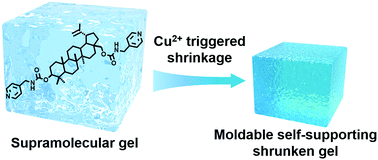Cu2+-triggered shrinkage of a natural betulin-derived supramolecular gel to fabricate moldable self-supporting gel†
Abstract
Most supramolecular gels have a poor ability to be molded into well-defined shapes, preventing them from having the same potential as clay-based and polymeric gels in applications. In this research, a natural betulin-derived bola-type amphiphile Py-BL was synthesized and found to assemble into a supramolecular gel with left-handed helices driven by hydrogen bonding and hydrophobic interactions. Due to the pyridine groups, which were able to coordinate metal ions and were sensitive to acidity, the resulting Py-BL gel exhibited responses to certain metal ions, and Cu2+-selective gel shrinkage was observed, with a contraction of the gel phase in three dimensions. The coordination between Cu2+ and pyridine groups in the ratio of 1 : 4 led to a cross-linked network of nanofibers and decreased the hydrophilic performance of the Py-BL gel, consequently causing the gelling solvent to extrude from the gel network with a macroscopic gel shrinkage. This Cu2+-triggered shrunken gel exhibited an improved rheological strength and could self-demold spontaneously through the shrinkage process with a precise amount of Cu2+. Using this strategy, we fabricated moldable self-supporting supramolecular gels with designed shapes and electrical conductivity. It is believed that the Cu2+-triggered shrinkage provides a novel approach to the fabrication of moldable self-supporting supramolecular gels at ultralow gelator loadings.



 Please wait while we load your content...
Please wait while we load your content...